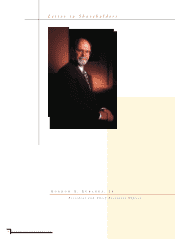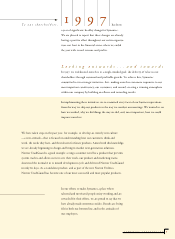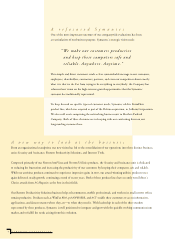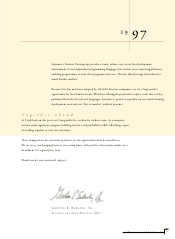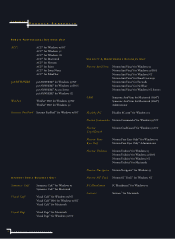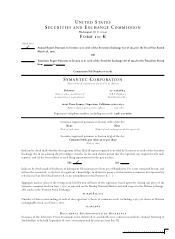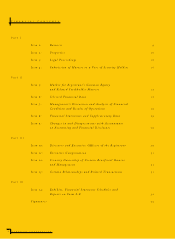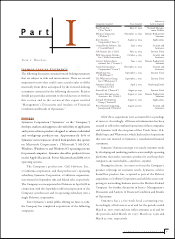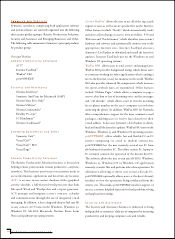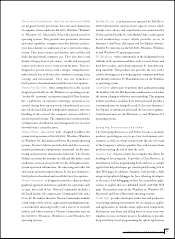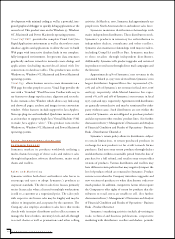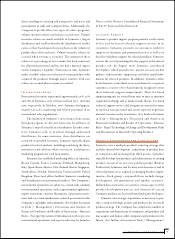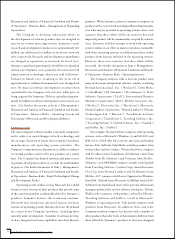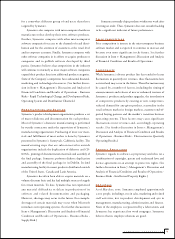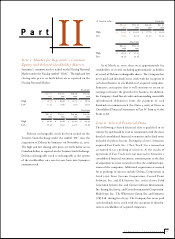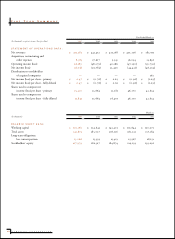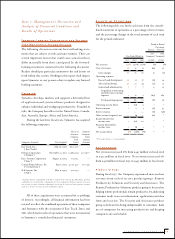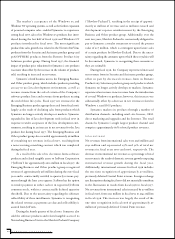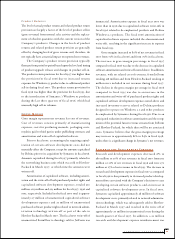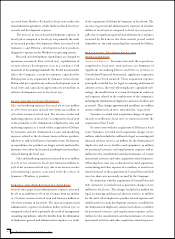Symantec 1997 Annual Report Download - page 14
Download and view the complete annual report
Please find page 14 of the 1997 Symantec annual report below. You can navigate through the pages in the report by either clicking on the pages listed below, or by using the keyword search tool below to find specific information within the annual report.
development with minimal coding as well as a powerful, inte-
grated graphical debugger to quickly debug applications at the
source level. This product runs on the Windows 95, Windows
NT, Macintosh and Power Macintosh operating systems.
Visual Café PRO provides the complete Visual Café Java
Rapid Application environment as well as the tools to create
database applets and applications to allow the user to build
Web pages with interactive database links in one complete,
fully-integrated environment. It represents data structures
graphically and uses wizards to instantly create dialogs and
applications (including master/detail joins) with live
connections to database tables. This product runs on the
Windows 95, Windows NT, Macintosh and Power Macintosh
operating systems.
Visual Page allows business users to create documents on a
Web page for other people to access. Visual Page provides the
user with a “Standard” Word Processor Toolbar with easy to
use features to change type face sizes, align text and set styles.
It also contains a Site Window which allows easy link setup
and shows all pages, anchors and images in one convenient
window. Other features include support for Java Applets,
Netscape plug-ins and embedded Quicktime movies as well
as an interface to support Apple Java Virtual Machine (VM)
to make Java applets “alive”. This product runs on the
Windows 95, Windows NT, Macintosh and Power Macintosh
operating systems.
Sales, International Sales and
Customer Support
Symantec markets its products worldwide utilizing a
multi-channel strategy of direct sales and indirect sales
through independent software distributors, major retail
chains and resellers.
Sales and Marketing
Symantec utilizes both direct and indirect sales forces to
encourage end users to adopt Symantec’s products as
corporate standards. The direct sales force focuses primarily
on site license sales where a license for multiple workstations
is sold to a customer at a negotiated price. The sales cycle
with respect to site license sales may be lengthy and may be
subject to integration and acceptance by the customer. The
Company also employs an indirect sales force that works
closely with its major distributor and reseller accounts to
manage the flow of orders, inventory levels and sell-through
to retail chains as well as promotions and other selling
activities. At March 31, 1997, Symantec had approximately 120
people in its North American direct and indirect sales force.
Symantec maintains distribution relationships with
major independent distributors. These distributors stock.
Symantec’s products in inventory for redistribution to
independent dealers, consultants and other resellers.
Symantec also maintains relationships with major retailers,
including CompUSA and Best Buy. Symantec markets
to these retailers through independent distributors.
Additionally, Symantec sells product upgrades and certain of
its products to end users through direct mail campaigns and
the Internet.
Approximately 34% of Symantec’s net revenues in the
year ended March 31, 1997 were derived from Symantec’s two
largest distributors. Ingram Micro, Inc. represented 27%,
27% and 22% of Symantec’s net revenues in fiscal 1997, 1996
and 1995, respectively, while Merisel Americas, Inc. repre-
sented 7%, 10% and 11% of Symantec’s net revenues in fiscal
1997, 1996 and 1995, respectively. Agreements with distributors
are generally nonexclusive and may be terminated by either
party without cause. Such distributors are not within the
control of Symantec, are not obligated to purchase products
and also represent other vendors’ product lines. (See further
discussion in Item 7: Management’s Discussion and Analysis
of Financial Condition and Results of Operations - Business
Risks - Distribution Channels.)
Symantec’s return policy allows its distributors, subject
to certain limitations, to return purchased products in
exchange for new products or for credit towards future
purchases. End users may return products through dealers
and distributors within a reasonable period from the date of
purchase for a full refund, and retailers may return older
versions of products. Various distributors and resellers may
have different return policies that may negatively impact the
level of products which are returned to Symantec. Product
returns occur when the Company introduces upgrades and
new versions of products or when distributors order too
much product. In addition, competitive factors often require
the Company to offer rights of return for products that dis-
tributors or retail stores are unable to sell. (See further
discussion in Item 7: Management’s Discussion and Analysis
of Financial Condition and Results of Operations - Business
Risks - Product Returns.)
Symantec’s marketing activities include advertising in
trade, technical and business publications, cooperative
marketing with distributors, resellers and dealers, periodic
12 SYMANTEC CORPORATION


